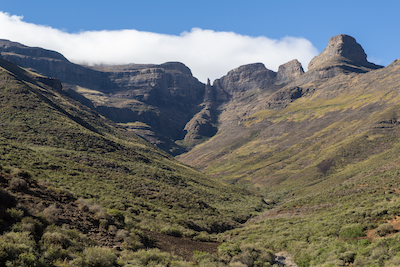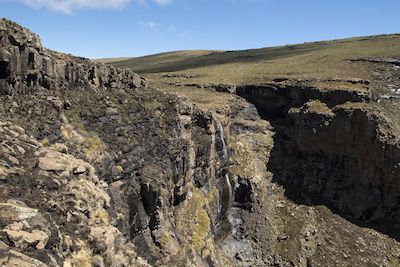
You are here: Explore > National Parks and Nature Reserves > Bokong Nature Reserve
Bisected by the surfaced A25 as it runs between Leribe and Katse Dam, lofty Bokong is a small but very scenic and hiker-friendly reserve spanning altitudes of 2,800 to 3,200 metres. It is best-known as the site of the attractive Lepaqoa Falls, which tumbles horseshoe-like over a 60-metre cliff, and often freezes in winter to form a column of solid ice.
 Bokong Nature Reserve is accessed via the Mafika Lisiu Pass, whose name alludes to a prominent rock formation said locally to resemble a maize bag. The pass reaches its misty windswept apex at an altitude of 3,090 metres, where a short side road leads to an impressive viewpoint over the relatively low-lying foothills to the west.
Bokong Nature Reserve is accessed via the Mafika Lisiu Pass, whose name alludes to a prominent rock formation said locally to resemble a maize bag. The pass reaches its misty windswept apex at an altitude of 3,090 metres, where a short side road leads to an impressive viewpoint over the relatively low-lying foothills to the west.
A short distance past the summit of Mafika Lisiu, Bokong Nature Reserve’s attractive clifftop Visitors' Centre overlooks the green valley carved by the Lepaqoa River and hosts an informative interpretative display. The centre also offers a distant view to Lepaqoa Falls, but for better views it is worth following the flattish 1.5km footpath that leads across a boulder-strewn highland meadow to a viewpoint directly above and opposite the waterfall.
 The footpath to the waterfall passes through highland bogs and fends that protect several endemic plan species and play an important ecological role sponging up rainwater in the wet season. During the drier winter months, this water is gradually released into the many montane streams that rise in the reserve, reinforcing its importance as a watershed.
The footpath to the waterfall passes through highland bogs and fends that protect several endemic plan species and play an important ecological role sponging up rainwater in the wet season. During the drier winter months, this water is gradually released into the many montane streams that rise in the reserve, reinforcing its importance as a watershed.
The grey rhebok, a medium-sized antelope endemic to southern Africa, is often seen running through the montane meadows of Bokong and easily recognised by the conspicuous fluffy white tail it holds aloft when in flight. The endangered Cape vulture breeds in the cliffs opposite the Visitor’s Centre. Other endemic birds likely to be seen include the handsome Drakensberg rockjumper, vociferous grey-winged Francolin, and peculiar ground woodpecker. A conspicuous seasonally flowering plant is the red-hot poker (Kniphofia spp), which often grows in fiery orange and yellow clumps close to streams.
Although most visitors stick to the short trail between the Visitors' Centre and the viewpoint to Lepaqoa Falls, hiking is permitted anywhere in the reserve. Bokong is also the starting point for a stunning two- to three-day 32km hike to Ts’ehlanyane National Park via an alpine plateau sometimes referred to as the Roof of Africa.
Sleeping: Simple budget-friendly self-catering accommodation is available at the Visitor’s Centre. There are also two overnight huts for hikers, with a kitchenette and an ablution facility, close to the Lepaqoa just above the waterfall. The nearby Katse Dam Lodge would also make a good base for a day visit.
Eating: Self-catering and picnics only. The closest proper supermarket is the Shoprite in Leribe.
Access: Bokong Nature Reserve lie about 150km from Maseru. To get there follow the A1 northeast as far as Hlotse, then turn southeast onto the A25 to Katse. Allow three hours for the drive. Any public transport between Hlotse and Katse Dam can drop you next to the Visitors' Centre, which is right alongside the A25.
Preparations: The use of a local guide is strongly encouraged as the weather in these high-altitude areas is very unpredictable. It also provides much needed employment for the local highland dwellers.


